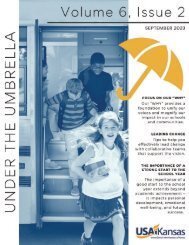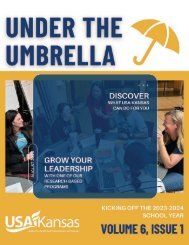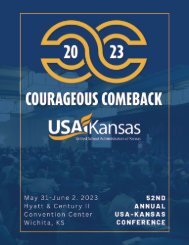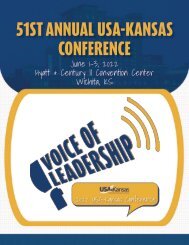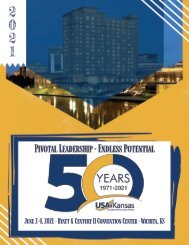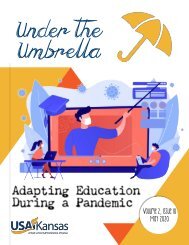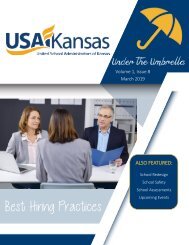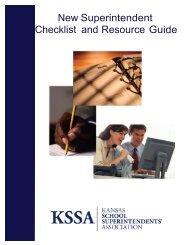Under the Umbrella, Volume 1, Issue 7
You also want an ePaper? Increase the reach of your titles
YUMPU automatically turns print PDFs into web optimized ePapers that Google loves.
<strong>Under</strong> <strong>the</strong> <strong>Umbrella</strong><br />
<strong>Volume</strong> 1, <strong>Issue</strong> 7<br />
February 2019<br />
ALSO FEATURED:<br />
SCHOOL REDESIGN<br />
SCHOOL SAFETY<br />
SCHOOL<br />
Women in Leadership<br />
ASSESSMENTS<br />
SELF CARE<br />
CAREER & TECH<br />
UPCOMING EVENTS
CONTENTS <strong>Volume</strong> 1, <strong>Issue</strong> 7<br />
2 Keeping in Touch During <strong>the</strong> Legislative Session, G.A. Buie<br />
WOMEN IN LEADERSHIP<br />
3 Women Make Great Leaders, Donna Zerr<br />
5 Does Gender Impact Leadership?, Suzan Patton<br />
SCHOOL REDESIGN<br />
6-7 Our Vision, Mission, & Goals? Where is <strong>the</strong> Fit in 2019?, Dr.<br />
John Vandewalle<br />
7 Redesign From Canton-Galva Schools, John Denk<br />
SCHOOL SAFETY<br />
10 Train According to <strong>the</strong> Possibilities, Not <strong>the</strong> Protocols, Doug<br />
Parisi<br />
11 Online Activity, Offline Trouble, Jeff Bean<br />
SCHOOL ASSESSMENTS<br />
12-13 We Can Do Better: 5 Guiding Principals for Improving Fluency<br />
Assessment, Cindy Jiban<br />
13 Teacher Evaluations Have Dramatically Changed <strong>the</strong><br />
Principal’s Job, Denisa R. Superville<br />
PRACTICING SELF CARE<br />
14-16 Live Well, Lead Well, Mark Wilson<br />
18-20 Improve Attendance, Behavior, and Academics! It Begins<br />
With This, Mark Wilson<br />
CAREER TECHNICAL EDUCATION<br />
22 Amazon Launches ‘Future Engineer’ Program to Aid Pursuit of<br />
Computer Science Careers, Lauraine Genota<br />
22 CTE Training Not New to High Schools, Jerry Henn<br />
24-25 Upcoming Events<br />
NETWORK & STAY CONECTED<br />
@USAKansas<br />
Facebook.com/USAKansas<br />
2018-2019 USA-Kansas<br />
Board of Directors<br />
Sean Cochran—President, KASEA<br />
Ryan Jilka—President Elect, KAMSA<br />
Pete Bastian—Past-President, KAESP<br />
Mike Berblinger—Director, KSSA<br />
Cory Gibson—Director, KSSA<br />
Eric Hensen—Director, KASBO<br />
Volora Hanzlicek—Director, KASCD<br />
Ron Barry—Director, KASSP<br />
Justin Henry—Director, KSSA<br />
Christie Meyer—Director, KASCD<br />
Bert Moore—Director, KASEA<br />
Suzan Patton—Director, KSSA<br />
Dennis Peerenboom—Director, KASPA<br />
Jake Potter—Director, KanSPRA<br />
P.J. Reilly—Director, KCCTEA<br />
Donna Schmidt—Director, KASSP<br />
Glen Suppes—Director, KSSA<br />
Patrick Schroeder—Director, KAESP<br />
Donna Zerr—Director, KASSP<br />
G.A. Buie—Executive Director<br />
Jerry Henn—Assistant Executive Director
KEEPING IN TOUCH DURING THE LEGISLATIVE<br />
SESSION<br />
G.A. Buie, Executive Director, USA-Kansas<br />
It has been eight long years<br />
since <strong>the</strong> democrats felt like<br />
<strong>the</strong>y had a say in Kansas<br />
Government. The election in<br />
November of 2010, put a wave<br />
of conservative republicans in<br />
control of <strong>the</strong> house, senate,<br />
and governor’s office. I am sure I do not have to<br />
tell you what happened next, even with a stronger<br />
moderate republican presence during <strong>the</strong> last four<br />
years, democrats often felt like outsiders looking<br />
in.<br />
Stay tuned with USA-Kansas as we keep you<br />
informed on <strong>the</strong> activities in <strong>the</strong> Capitol; we have<br />
already started with our weekly Capitol Connection<br />
released on Friday’s. The Connection is a one to<br />
two-page weekly update including bills, testimony,<br />
and activities in <strong>the</strong> Capitol. The Capitol Chatter is<br />
posted on Mondays and <strong>the</strong> Chatter includes a<br />
behind closed door look at what is happening<br />
around <strong>the</strong> Capitol hallways. Each of <strong>the</strong>se updates<br />
and more will be shared through our USA-Kansas<br />
App and will be stored on <strong>the</strong> USA-Kansas<br />
members only portion of our website.<br />
Following Governor Kelly’s State of <strong>the</strong> State<br />
speech, KASB and USA-Kansas hosted a reception<br />
for all legislators, but it was <strong>the</strong> democrats who<br />
had <strong>the</strong> extra pep in <strong>the</strong>ir step. Granted, <strong>the</strong><br />
republicans still maintain advantage in both <strong>the</strong><br />
House and Senate but having a democrat in <strong>the</strong><br />
Governor’s office helps set <strong>the</strong> tone. Kelly clearly<br />
put education and educators at <strong>the</strong> top of her<br />
agenda.<br />
Download <strong>the</strong><br />
USA-Kansas App!<br />
Search for USAK in <strong>the</strong><br />
app store or use this<br />
QR code for fast<br />
access!<br />
2
WOMEN IN LEADERSHIP<br />
WOMEN MAKE GREAT LEADERS<br />
Donna Zerr, Principal of Augusta High School, USA-Kansas Board of Directors<br />
Growing up, my teachers, friends,<br />
and even my mo<strong>the</strong>r told me I was<br />
too bossy. What if <strong>the</strong>y would have<br />
told me I had excellent leadership<br />
skills instead? J Women make great<br />
leaders! The odds are against us to<br />
lead – it takes <strong>the</strong> added push to<br />
get to <strong>the</strong> top. Most women who<br />
emerge on top are extraordinarily sharp and vibrant.<br />
I’ve learned so much throughout my career from o<strong>the</strong>r<br />
women who have excellent leadership skills based on<br />
<strong>the</strong>ir individual strengths and <strong>the</strong>ir personality traits.<br />
Maybe “bossy” wasn’t <strong>the</strong> best description; however,<br />
it’s imperative that we continue to encourage women<br />
to capitalize on <strong>the</strong>ir skills to take on those leadership<br />
positions.<br />
Just a few weeks ago, Laura Kelly was inaugurated as<br />
<strong>the</strong> governor of Kansas. What an inspiration she is as a<br />
female in <strong>the</strong> top position of our state government!<br />
We need to continue to follow women such as her to<br />
learn, grow, and develop women in leadership<br />
positions. I’ve had many women as role models for<br />
me, and I enjoy discussing, questioning and emulating<br />
<strong>the</strong>m, to establish <strong>the</strong> quality traits that make <strong>the</strong>m so<br />
successful. Women can learn from o<strong>the</strong>r women, and<br />
that’s how we will keep <strong>the</strong>m in prominent and<br />
influential roles. Ano<strong>the</strong>r method I like to employ is to<br />
read books and watch movies about inspiring women<br />
who have leadership influences. Below I’ve listed and<br />
briefly described a few books that anyone (female or<br />
male) might enjoy and increase <strong>the</strong>ir knowledge and<br />
appreciation of women leaders.<br />
Lean In: Women, Work and <strong>the</strong> Will to Lead by Sheryl<br />
Sandberg<br />
Sandberg examines why women’s progress in achieving<br />
leadership roles has stalled, explains <strong>the</strong> root causes,<br />
and offers compelling, commonsense solutions that can<br />
empower women to reach <strong>the</strong>ir full potential.<br />
Leading Women: 20 Influential Women Share Their<br />
Secrets to Leadership, Business, and Life by Nancy D<br />
O’Reilly<br />
A good read for women looking to go beyond obstacles<br />
and skillfully overcome stereotypes. This book offers<br />
insights of multiple women and will leave you inspired.<br />
Leading Gracefully: A Woman’s Guide to Confident,<br />
Au<strong>the</strong>ntic & Effective Leadership by Monique Svazlian<br />
Tallon<br />
This book covers leadership styles, collaboration, and<br />
finding <strong>the</strong> balance of women’s inner qualities and<br />
established rules of business.<br />
New Rules of <strong>the</strong> Game: 10 Strategies for Women in <strong>the</strong><br />
Workplace by Susan Packard<br />
Packard shares her career story with humor, including<br />
<strong>the</strong> successes and <strong>the</strong> mistakes. She provides you with<br />
insight and inspiration to play <strong>the</strong> business game<br />
smarter, stronger, and more successfully.<br />
Thrive by Arianna Huffington<br />
This book is about taking care of yourself as much as<br />
your work. Arianna tells a personal story of her health,<br />
her life, and her job and how she juggles it all.<br />
"No country can ever truly flourish if it stifles <strong>the</strong><br />
potential of its women and deprives itself of <strong>the</strong><br />
contributions of half of its citizens." -- Michelle<br />
Obama, First Lady of <strong>the</strong> United States<br />
Women in Leadership<br />
• Defy <strong>the</strong> odds<br />
• Are flexible<br />
• Lead by example<br />
• Wear many hats<br />
• Handle crisis situations well<br />
• Communicate effectively<br />
• Can multitask successfully<br />
• Motivated by challenges<br />
• Are great listeners<br />
• Focus on teamwork<br />
• Empa<strong>the</strong>tic and nurturing<br />
• Value work-life balance<br />
3
DOES GENDER IMPACT LEADERSHIP?<br />
Suzan Patton, Superintendent of Pratt Public Schools, USA-Kansas Board of Directors<br />
Are <strong>the</strong>re leadership differences<br />
between men and women<br />
superintendents because of <strong>the</strong>ir<br />
gender? Are <strong>the</strong>re differences<br />
between Laura Kelly and Kathleen<br />
Sebelius? Both elected governor<br />
of Kansas. How about Donald<br />
Trump and Barack Obama? Both elected president of<br />
<strong>the</strong> United States? See any similarities or differences?<br />
Fundamentally, are leadership styles about gender or<br />
simply <strong>the</strong> amalgamation of one’s own values,<br />
background, personality?<br />
My experiences<br />
and observations<br />
as a female district<br />
leader suggest that<br />
gender differences<br />
do not play a role<br />
in <strong>the</strong> strengths or weaknesses of a superintendent. I<br />
am <strong>the</strong> sum total of my inherited and learned<br />
leadership skills and individual personality, not my<br />
gender.<br />
I am <strong>the</strong> sum total of my<br />
inherited and learned<br />
leadership skills and<br />
individual personality,<br />
not my gender.<br />
The significance of culture could not have been<br />
demonstrated any clearer than watching <strong>the</strong><br />
Alabama-Clemson National Football Championship<br />
and listening to post-game comments from team<br />
leaders, coaches and players. Clemson’s Dabo<br />
Swinney used words like “love, family, our players<br />
and staff.” Guess which words came out of his<br />
quarterback’s mouth, “love, family, <strong>the</strong> seniors, and<br />
coaching staff.” Notice a similarity? One of <strong>the</strong><br />
Tigers’ senior linemen talked about loving his<br />
coaches. No doubt <strong>the</strong>y were overly joyed in <strong>the</strong><br />
moment of victory, but to repeatedly hear <strong>the</strong> same<br />
phrases suggests those words are part of <strong>the</strong><br />
culture. Coach Swinney, as <strong>the</strong>ir leader, has<br />
established common <strong>the</strong>mes. Ask any K-Stater<br />
about Bill Snyder and family is a recurring <strong>the</strong>me.<br />
There’s a reason family is part of <strong>the</strong> K-State’s<br />
stadium. I don’t think it’s any accident; both Snyder<br />
and Swinney know <strong>the</strong> importance of establishing<br />
<strong>the</strong> right culture for success.<br />
For instance, as a district leader, my fundamental<br />
core focus is district culture. By surrounding myself<br />
with <strong>the</strong> people who share my core values,<br />
compensate for my weaknesses and accentuate my<br />
strengths, and share my vision through teamwork,<br />
we create a culture where people want to come to<br />
work every day and do <strong>the</strong>ir best. If bus drivers,<br />
paras, custodians and teachers are doing <strong>the</strong>ir best,<br />
<strong>the</strong>y create a culture where our students will be<br />
successful. Culture is not a male/female leadership<br />
focus; culture is a value held by many<br />
superintendents, male AND female.<br />
How superintendents lead <strong>the</strong>ir districts is not a<br />
matter of gender. Superintendents are humans who<br />
are called to lead and bring many skills, not just pink<br />
or blue ones, to <strong>the</strong> job. What’s more, as Coach<br />
Dabo says, leaders, “B.Y.O.G. (Bring Your Own<br />
Guts.)”<br />
5
SCHOOL REDESIGN<br />
OUR VISION, MISSION, & GOALS? WHERE IS THE FIT IN 2019?<br />
Dr. John Vandewalle, CEO Lumen Touch, johnv@lumentouch.com<br />
It’s a New Year and we have just rung it<br />
in 2019.<br />
New Year resolutions are said<br />
to have evolved from <strong>the</strong><br />
days of <strong>the</strong> Babylonians when<br />
in spring as <strong>the</strong> lands were<br />
readied to seed, <strong>the</strong> new king was elected or<br />
allegiance to <strong>the</strong> reigning king was reaffirmed. At<br />
this time <strong>the</strong> populace would make promises to <strong>the</strong><br />
gods to pay <strong>the</strong>ir debts and return borrowed items<br />
to <strong>the</strong>ir owners. If <strong>the</strong>y obeyed, <strong>the</strong>y were given<br />
favor by <strong>the</strong> gods o<strong>the</strong>rwise <strong>the</strong>y were condemned.<br />
This was away of creating<br />
accountability and striving<br />
for good.<br />
Our accountabilities in our<br />
organizations are embedded<br />
in our vision, mission, values<br />
and goals. Since we are all in <strong>the</strong> mood for<br />
resolutions at this time of <strong>the</strong> year, let’s cash in<br />
while <strong>the</strong> emotions are blowing in our favor. Let’s<br />
reinforce <strong>the</strong> change we are bringing about for <strong>the</strong><br />
sake of our students. Let’s give <strong>the</strong>m <strong>the</strong> best start<br />
in <strong>the</strong>ir lives so that <strong>the</strong>y too will be making high<br />
aspiration resolutions and hold <strong>the</strong>mselves<br />
accountable.<br />
“What leadership skills are you going to exercise to<br />
exemplify your conviction to a new world of<br />
education?” “What will you do in 2019 to<br />
dramatically improve <strong>the</strong> well being of all our<br />
students?” “Can you visualize 2019 and be sure it<br />
6<br />
is dramatically different to<br />
2017 and unrecognizable<br />
from 2016?” “Can you<br />
support <strong>the</strong> dream that Dr.<br />
Randy Watson has visualized<br />
for us?”<br />
As we ventured into <strong>the</strong> universe of Gemini and<br />
Mercury schools in <strong>the</strong> universe of Kansas, we came<br />
across two episodes that are worthy of mention.<br />
Teen is getting his high school and<br />
Harvard diplomas in <strong>the</strong> same month<br />
Braxton Moral from Ulysses,<br />
Kansas has achieved what many<br />
16-year old’s would love to<br />
achieve when he graduates a<br />
high school diploma and<br />
bachelor’s degree at <strong>the</strong> same<br />
time. Carlos Moral, his fa<strong>the</strong>r said <strong>the</strong>y began to<br />
realize <strong>the</strong>ir son was special when he was in <strong>the</strong><br />
third grade.<br />
This is an example of where leadership and<br />
resolutions came into play years ago that bore <strong>the</strong><br />
fruit of vision, mission and goals. This is where an<br />
independent plan of study worked; this is where <strong>the</strong><br />
system was challenged; this is where <strong>the</strong> leadership<br />
showed that <strong>the</strong>re is a better but different way.<br />
School District in Kansas<br />
is showing <strong>the</strong> way<br />
Dighton Unified School District<br />
482 is a Gemini District and is<br />
venturing its course!<br />
“By being a Gemini district, we<br />
drive <strong>the</strong> changes in our
approach and how those approaches will best benefit<br />
our kids. We are moving toward a more modernized<br />
educational system based on student choice, real-life<br />
skills and improved concept mastery.” said<br />
Superintendent Dr. Kelly Arnberger.<br />
They want to be sure <strong>the</strong>y don’t miss <strong>the</strong><br />
opportunities for all students. How do <strong>the</strong>y know<br />
<strong>the</strong>y are different? Well, o<strong>the</strong>rs are wanting to see<br />
what <strong>the</strong>y are doing so now <strong>the</strong>y have a new<br />
responsibility. They have to manage all <strong>the</strong> visitors<br />
and <strong>the</strong> way <strong>the</strong>y tell <strong>the</strong>ir story while continuing to<br />
focus on <strong>the</strong>ir space and <strong>the</strong>ir journey to excellence.<br />
Next month’s edition will bring some challenges of<br />
Dighton’s journey as <strong>the</strong>y strive to become <strong>the</strong><br />
picture of a Gemini District in an interview with some<br />
of <strong>the</strong>ir leadership team. See you in this SPACE.<br />
REDESIGN FROM<br />
CANTON-GALVA SCHOOLS<br />
John Denk, Superintendent of Canton-Galva<br />
Schools<br />
As I look back to <strong>the</strong> beginning of our journey into <strong>the</strong><br />
redesign process, I am amazed by <strong>the</strong> power of our<br />
educational community. Canton-Galva USD 419<br />
teachers, CGKNEA and USD 419 School Board were<br />
willing to take a leap of faith to choose this journey.<br />
To comprehend <strong>the</strong> strength of this initiative, you<br />
first have to understand that I was a first-year<br />
superintendent. When <strong>the</strong> call went out for districts<br />
to volunteer to redesign <strong>the</strong>ir schools, we had just<br />
ended our school year; our teachers were gone for<br />
<strong>the</strong> summer. Needless to say, it took a great deal of<br />
courage, professionalism, and faith for our teachers<br />
to accept this challenge under those circumstances.<br />
Personalized learning is a principle of redesign that<br />
we, as a district staff, believed could have <strong>the</strong><br />
greatest impact on <strong>the</strong> learning of our students.<br />
Through our discussions, we determined that<br />
blended learning and project-based learning (PBL)<br />
were <strong>the</strong> best practice tools to initiate personalized<br />
learning for our students. Blended learning would be<br />
<strong>the</strong> foundation for instruction with PBL woven into<br />
<strong>the</strong> foundation to streng<strong>the</strong>n learning and provide<br />
greater application of knowledge. We hired trainers<br />
who could come to our district and empower our<br />
staff using methods on how to create a Blended<br />
Learning Environment. We targeted leveled<br />
instruction with one elementary trainer and one<br />
secondary trainer who are spending two days per<br />
month during <strong>the</strong> 2018-19 school year with our staff.<br />
This approach has had a tremendous impact on our<br />
teachers; we are already seeing a transformation<br />
within in our classrooms. The focus is evolving our<br />
classrooms from a teacher-centered model to a<br />
student-centered environment. While we still have<br />
much to learn before we reach <strong>the</strong> level of<br />
personalization that we wish to attain, we feel we<br />
are on <strong>the</strong> right path. The Canton-Galva staff is<br />
gaining knowledge, experience, and confidence<br />
through what <strong>the</strong>y have learned, and <strong>the</strong>y are now<br />
implementing <strong>the</strong>se skills in <strong>the</strong>ir classrooms. As our<br />
teachers grow, so to do our students. Our goal is to<br />
challenge our students to think, to be creative, and<br />
to solve problems on <strong>the</strong>ir own or through<br />
collaboration with o<strong>the</strong>rs. We want our students to<br />
be self-regulated and to take <strong>the</strong> initiative to find<br />
<strong>the</strong>ir own solutions.<br />
In addition, we are adapting <strong>the</strong> physical learning<br />
environment in our schools. Our libraries are being<br />
transformed into collaboration spaces and individual<br />
study spots. We are creating tinker spaces and<br />
maker spaces in which students may be creative<br />
learners. We are also providing alternate seating in<br />
7
our classrooms.<br />
All of <strong>the</strong>se<br />
changes are<br />
designed to make<br />
our schools an<br />
inviting,<br />
comfortable and<br />
exciting place for<br />
students to learn.<br />
Fur<strong>the</strong>rmore, it is<br />
exciting to see<br />
<strong>the</strong> opportunities that are opening for our students<br />
with college and career readiness initiatives including<br />
job shadowing and internships. In addition, social/<br />
emotional initiatives like our elementary school<br />
“families” address SE topics in multi-age groups. I<br />
cannot share everything we have on our agenda in<br />
our redesign, but I can tell you that <strong>the</strong> process of<br />
examining our district and determining how we<br />
design it around our students’ needs has been<br />
exciting, challenging, and rewarding.<br />
What we have found is that <strong>the</strong> redesign process has<br />
been a positive experience for our district. I won’t tell<br />
you that everything has been easy or that it has all<br />
gone smoothly; however, I can say that we have<br />
grown as a staff and as a district, that positive<br />
changes are taking place, and that we are continuing<br />
to learn through this process. There is a lot of hard<br />
work, fear and doubt that has to be addressed as we<br />
work through <strong>the</strong> redesign process, but our<br />
experience so far is that by accepting <strong>the</strong> challenge of<br />
redesign, we will grow as a staff in ways we never<br />
would have o<strong>the</strong>rwise. Take <strong>the</strong> leap. We did and it is<br />
worth it.<br />
Retirement Plan Contribution Limit Changes<br />
for 2019<br />
403(b)/ Roth 403(b) / 457 Elective Deferral<br />
Limit<br />
Pre-tax 403(b)/ after-tax Roth 403(b) /<br />
457 contribution limit will go up by $500<br />
from $18,500 in 2018 to $19,000 in 2019.<br />
If you are age 50 or over, <strong>the</strong> catch-up<br />
contribution limit will stay <strong>the</strong> same at<br />
$6,000 in both 2018 and 2019. The 457-<br />
plan limit is separate. You can contribute<br />
to both a 403(b) plan and a 457 plan.<br />
Traditional and Roth IRA Contribution Limit<br />
The pre-tax Traditional and after-tax Roth<br />
IRA contribution limit will go up by $500<br />
from $5,500 in 2018 to $6,000 in 2019.<br />
The age 50 catch up limit is fixed by law at<br />
$1,000 in all years. The IRA contribution<br />
limits and <strong>the</strong> 403(b) limits are separate.<br />
You can contribute to both a 403(b) plan<br />
and a traditional or Roth IRA.<br />
http://www.ameritimeks.com/<br />
Securities offered through Securities America, Inc., member FINRA/SIPC.<br />
Advisory services offered through Securities America Advisors, Inc.<br />
Ameritime, LLC and Securities America are separate entities.<br />
8
SCHOOL SAFETY<br />
TRAIN ACCORDING TO THE POSSIBILITIES, NOT<br />
THE PROTOCOLS<br />
Doug Parisi, SafeDefend<br />
With <strong>the</strong> changes to <strong>the</strong> crisis drill<br />
requirements in Kansas, <strong>the</strong><br />
addition of intruder response drills<br />
and lockdown drills have been an<br />
overall positive thing. Most school<br />
administrators had already added<br />
<strong>the</strong>se types of drills to <strong>the</strong><br />
preparedness training by staff. At<br />
SafeDefend we encourage schools to regularly discuss<br />
response options and consider scenarios for notification<br />
in <strong>the</strong> event of hostile intruders. The manner in which<br />
<strong>the</strong>se drills are conducted, however, can greatly impact<br />
<strong>the</strong> way <strong>the</strong> information is conveyed and maintained.<br />
The idea should always be to prepare not to scare.<br />
Fire drills and tornado drills have consistent response<br />
protocols. Regardless of where <strong>the</strong> fire starts <strong>the</strong> goal<br />
is to exit <strong>the</strong> building. A tornado warning clearly<br />
indicates <strong>the</strong> need to take shelter in designated areas.<br />
Very little deviation from <strong>the</strong>se protocols is required.<br />
Practicing <strong>the</strong>se responses and having students be<br />
familiar with expectations is necessary to achieve <strong>the</strong><br />
goal of keeping everyone safe.<br />
Hostile intruder drills cannot be so easily handled.<br />
There is no one response option that keeps everyone<br />
safe. Real attacks have demonstrated that <strong>the</strong> events<br />
10<br />
are fluid and require various responses. Simply<br />
instructing staff to lockdown and wait is an option but it<br />
shouldn’t be <strong>the</strong> only option. Teachers and staff need<br />
to understand that until help arrives <strong>the</strong>ir actions can<br />
have important consequences. If you can get out safely<br />
<strong>the</strong>n that should be an option as well. If <strong>the</strong> intruder is<br />
trying to get into <strong>the</strong> classroom be prepared to drive<br />
<strong>the</strong>m back out. In order to accomplish this <strong>the</strong> drills<br />
should revolve around mental exercises and discussions<br />
about options. Having kids hide in a corner while <strong>the</strong><br />
teacher locks <strong>the</strong> door and turns out <strong>the</strong> lights does not<br />
prepare <strong>the</strong>m to adapt when <strong>the</strong> situation changes.<br />
Staff should spend<br />
more time learning how<br />
to communicate a<br />
threat over <strong>the</strong><br />
intercom with simple<br />
commands like<br />
‘Lockdown, Lockdown,<br />
Cafeteria Intruder!’<br />
Staff that are informed<br />
can make immediate<br />
critical decisions that<br />
will reduce casualties<br />
and save lives. Simply hoping that police will arrive in<br />
time and locate <strong>the</strong> intruder has shown to fail time and<br />
again. Empowering staff and faculty can have<br />
measurable results.
COMMUNICATION<br />
CORNER<br />
ONLINE ACTIVITY,<br />
OFFLINE TROUBLE<br />
Jeff Bean, NAESP Principal<br />
School Safety & Security – Three Steps for<br />
Safer Schools<br />
Submitted by Michele Jones, Director of Communications and<br />
School Safety, USD 383 Manhattan-Ogden<br />
Three school safety related tasks that school districts<br />
should accomplish this semester:<br />
1. Contact your local first responders and ask for<br />
<strong>the</strong>ir help in developing (or reviewing) a safety<br />
plan. It is in everyone’s best interest for schools<br />
and first responders to work toge<strong>the</strong>r to build<br />
<strong>the</strong> safety plan. Those first responders will be on<br />
scene first, so it is important that <strong>the</strong>y know <strong>the</strong><br />
plan, as well as <strong>the</strong> school. Work toge<strong>the</strong>r and<br />
seek assistance from <strong>the</strong> Kansas Safe and Secure<br />
Schools Unit through KSDE.<br />
2. Number exterior doors. Number doors starting<br />
at <strong>the</strong> front door and go clockwise around <strong>the</strong><br />
building - <strong>the</strong> front door will be 1. Use vinyl-type<br />
number labels that are large enough to be seen<br />
from a distance. Label both <strong>the</strong> exterior and<br />
interior of <strong>the</strong> door. Place <strong>the</strong> number in <strong>the</strong><br />
same location on each door (ex. top right<br />
corner). This is a straight forward way to assist<br />
first responders with navigating your building<br />
campus, even if <strong>the</strong>y have never been on site<br />
before.<br />
3. Update your building maps. When was <strong>the</strong> last<br />
time <strong>the</strong> school map was updated? Do your first<br />
responders have current maps of all school<br />
buildings? Items to include on <strong>the</strong> map: exterior<br />
door numbers, severe wea<strong>the</strong>r shelter area(s),<br />
elevator location, water, gas, and electrical shutoff<br />
valves, fire alarm control panel, annunciator<br />
panel, interior classroom numbers.<br />
Any time is a good time to build positive relationships<br />
with your community's emergency management<br />
professionals, and engage <strong>the</strong>m in ensuring <strong>the</strong><br />
safety and security of your staff and students. Don't<br />
make <strong>the</strong> mistake of waiting until <strong>the</strong>re is a crisis to<br />
begin having <strong>the</strong>se important conversations.<br />
Bullying and violence often begin in <strong>the</strong> virtual world<br />
and on social media before entering schools.<br />
Cyberbullying and school violence have reached<br />
epidemic proportions in our country. People can<br />
engage in intellectual debates on <strong>the</strong> causes of <strong>the</strong>se<br />
problems and <strong>the</strong>ir solutions, but <strong>the</strong>re can be no<br />
doubt that <strong>the</strong> digital world in which our kids now<br />
live has produced harmful effects.<br />
Having been a School Resource Officer (SRO) in a<br />
junior high school, I’ve seen it with my own eyes. It is<br />
not <strong>the</strong> same school setting we had a generation ago.<br />
Today’s youth are more likely to communicate using<br />
electronics than <strong>the</strong>y are to talk face-to-face. And<br />
<strong>the</strong>y are having a harder time maintaining<br />
communication through conflict, because <strong>the</strong>y ei<strong>the</strong>r<br />
don’t need to or don’t know how.<br />
Click Here to view full story.<br />
11
SCHOOL ASSESSMENTS<br />
WE CAN DO BETTER: 5 GUIDING PRINCIPALS FOR IMPROVING<br />
FLUENCY ASSESSMENT<br />
Cindy Jiban, PhD<br />
Oral reading fluency<br />
assessment is now<br />
commonplace in<br />
American primary<br />
grades classrooms.<br />
Getting to this point<br />
has been an<br />
incredible victory for data-based problem solving in<br />
education. However, given some of <strong>the</strong> side-effects that<br />
have emerged, it is clear that oral reading fluency<br />
assessment is due for significant structural improvement.<br />
Educators and early learning experts at NWEA® recently<br />
tackled <strong>the</strong> problem of next generation fluency<br />
assessment. In <strong>the</strong> process, we talked about <strong>the</strong> role of<br />
comprehension, rate, and accuracy. Here, we offer <strong>the</strong><br />
five guiding principles that could improve fluency<br />
assessment.<br />
Let’s keep comprehension central<br />
In many systems, oral reading fluency is assessed in<br />
isolation—without comprehension checks on what <strong>the</strong><br />
student reads aloud. So instead of adjusting <strong>the</strong>ir rate to<br />
best support <strong>the</strong>ir own understanding, most kids aim to<br />
read as quickly as possible. If we want to keep reading<br />
comprehension as <strong>the</strong> central goal in literacy instruction,<br />
<strong>the</strong>n we need to attend to <strong>the</strong> message we are sending<br />
kids. It’s not that better reading is faster reading; instead,<br />
better reading means getting more from <strong>the</strong> text.<br />
When oral reading fluency is positioned as a gauge of<br />
word automaticity, <strong>the</strong> downward extensions follow suit:<br />
<strong>the</strong>y focus only on skills that support word decoding. We<br />
do not, however, see much downward extension for<br />
comprehension. This is tragic given what we know from<br />
research: early oral language comprehension is a crucial<br />
predictor of later success in reading comprehension.<br />
12<br />
01 Principle for improvement: Emphasize comprehension<br />
across <strong>the</strong> board. We need to ask kids to show<br />
comprehension of what <strong>the</strong>y read aloud. In assessing kids<br />
who can’t yet read passages, we need to incorporate oral<br />
language comprehension, not just early decoding skills.<br />
Let’s adapt to assess where growth is meaningful<br />
Increases in words correct per minute (WCPM) are<br />
most meaningful as kids are developing some<br />
automaticity with words. The sweet spot is from<br />
about 10 WCPM to about 90 WCPM; this growth is<br />
important in freeing up some mental space, so that a<br />
student’s attention is no longer fully spent on<br />
sounding out, re-trying, and self-correcting at <strong>the</strong><br />
single word level.<br />
But for kids who are reading smoothly from gradelevel<br />
text—and understanding it—we don’t care if<br />
<strong>the</strong>y can read faster. For <strong>the</strong>se kids, meaningful<br />
growth is about handling harder and harder texts with<br />
good comprehension.<br />
02 Principle for improvement: Adapt text level for<br />
passage readers. If we don’t want to send <strong>the</strong> message<br />
that faster is better, <strong>the</strong>n we need to get beyond <strong>the</strong> onesize-fits-all<br />
approach of assessing all kids only on grade<br />
level text.<br />
Oral reading fluency assessment can fail kids on <strong>the</strong><br />
lower end of reading development, too. Some not-yet<br />
-reading kids are at zero words per minute in <strong>the</strong> fall,<br />
and still at zero in <strong>the</strong> winter. So—no growth in<br />
literacy? That’s typically not <strong>the</strong> case. We know that<br />
for <strong>the</strong>se kids, meaningful growth is happening in<br />
foundational decoding skills and in oral language<br />
comprehension.
03 Principle for improvement: Adapt to measure<br />
emergent readers where <strong>the</strong>y are growing. When a reader<br />
can’t yet identify enough words to handle connected text,<br />
time is better spent assessing what’s useful now in<br />
instruction: foundational decoding and oral language<br />
skills.<br />
Let’s minimize <strong>the</strong> time spent on testing<br />
In many schools, all students in first and second<br />
grades are given oral reading fluency assessments<br />
one on one. An efficient teacher might collect<br />
WCPM data on her whole class in three days of<br />
reading block time – and <strong>the</strong>n do that again in<br />
winter and in spring. And in o<strong>the</strong>r classrooms,<br />
teachers prefer one-on-one assessments that can<br />
take upwards of half an hour per child. The time<br />
taken from instruction to do assessment adds up<br />
quickly.<br />
04 Principle for improvement: Assess efficiently. We need<br />
to support high-quality teacher student interactions in<br />
literacy instruction.<br />
Let’s use tools to advance ra<strong>the</strong>r than duplicate<br />
Today, more than half of American teachers report<br />
using 1:1 computing, where each student has a<br />
laptop or tablet. We all have a phone that processes<br />
speech input masterfully. It’s clearly time to use<br />
technology to redesign fluency assessment for <strong>the</strong><br />
better.<br />
05 Principle for improvement: Use technology to raise <strong>the</strong><br />
bar. Instead of just replicating what we’ve done for<br />
decades onto an electronic screen, let’s use technology to<br />
do things smarter and more efficiently. Computer<br />
adaptive testing and speech recognition offer two obvious<br />
places to start.<br />
We honor <strong>the</strong> research and <strong>the</strong> leadership that got<br />
us to where we are today in oral reading fluency<br />
assessment. It’s possible to make it even better.<br />
Learn more about our approach to early reading<br />
assessments at nwea.org.<br />
TEACHER EVALUATIONS<br />
HAVE DRAMATICALLY<br />
CHANGED THE<br />
PRINCIPAL’S JOB<br />
Denisa R. Superville, Education Week<br />
The pitched battles that once waged over morerigorous<br />
teacher evaluations have long since<br />
quieted, but <strong>the</strong>re's a lasting legacy of those<br />
systems: They have fundamentally changed <strong>the</strong><br />
principal's job.<br />
They have increased principals' attention to<br />
instruction and what's happening in classrooms. But<br />
at <strong>the</strong> same time, <strong>the</strong>y have created monumental<br />
time-management challenges for principals that<br />
could lead to turnover and burnout.<br />
That's according to a new paper published online<br />
last month in <strong>the</strong> Elementary School Journal, in<br />
which researchers from North Carolina State<br />
University, <strong>the</strong> University of Michigan, and<br />
Vanderbilt University examined how multiplemeasure<br />
teacher evaluations adopted as a result of<br />
<strong>the</strong> Obama administration's Race To The Top<br />
competitive grant program—and still largely in<br />
place in many states—have redefined <strong>the</strong><br />
principal's role.<br />
13<br />
Click Here to view full story.
PRACTICING SELF CARE<br />
LIVE WELL, LEAD WELL<br />
Mark Wilson, The Principal Matters<br />
What is <strong>the</strong> framework we use to guide us in our<br />
work as school leaders? In o<strong>the</strong>r words, why do you<br />
lead your school <strong>the</strong> way you do?<br />
Most of us lead based on <strong>the</strong> experiences we've<br />
had. Sometimes we lead as we've been led, and<br />
o<strong>the</strong>r times our prior experiences teach us what<br />
NOT to do.<br />
We can have more effective schools if we have<br />
more effective leaders, but you won't DO well<br />
unless you LIVE well. What does that entail? Let's<br />
look at five areas.<br />
1. Bring awareness to Stress and Wellness;<br />
What gets talked about gets done. If you want to<br />
have a culture of wellness at your school, talk about<br />
it. Talk ABOUT stress; not around it. Everyone has<br />
stress and teachers/administrators are no<br />
exception. The first step, as <strong>the</strong>y always say, is<br />
acknowledging <strong>the</strong> problem, and we know that<br />
stress is a problem for teachers and administrators.<br />
There's a part of <strong>the</strong> "how to be a school leader"<br />
narrative that we continue to perpetuate that you<br />
might want to reconsider. It's <strong>the</strong> framework that's<br />
based on: 1) working all of <strong>the</strong> time; 2) not<br />
recognizing or addressing <strong>the</strong> stress of <strong>the</strong> job; and,<br />
3) falling out of balance with <strong>the</strong> o<strong>the</strong>r facets of your<br />
life.<br />
We have seen this as <strong>the</strong> norm for principals and<br />
assistant principals for a number of years now, and<br />
it's time to consider ano<strong>the</strong>r approach on HOW to<br />
be an effective principal.<br />
That approach? Live well, lead well.<br />
You can rightly assume that <strong>the</strong> reverse of this<br />
approach is also true: If you don't live well, you<br />
won't lead well. At least not for very long.<br />
14<br />
But, we also know that wellness is a solution to that<br />
problem. What would it be like if staff wellness was<br />
a cornerstone belief for your school or your<br />
system? How might that positively impact<br />
relationships between teachers and<br />
students? Teachers and o<strong>the</strong>r colleagues?<br />
What good might <strong>the</strong> example of wellness bring to<br />
your students and your community? How might it<br />
directly impact <strong>the</strong> performance of teachers and of<br />
students?<br />
So, here's <strong>the</strong> truth: you ei<strong>the</strong>r have an intentional<br />
effort to focus on wellness, or you are just hoping<br />
for <strong>the</strong> best. The challenge behind that "strategy"<br />
lies within <strong>the</strong> increasing levels of stress reported<br />
by teachers and administrators. We need a better<br />
plan than to hope everyone makes it.<br />
2. Establish Live Well/Lead Well as a norm, and not<br />
exception of afterthought.<br />
The answer for staff well being is NOT a once-a-year<br />
promotion for losing weight. It also is not
sponsoring a 5K in <strong>the</strong> fall. Those activities can serve<br />
to be a part of an emphasis on wellness, but we are<br />
fooling ourselves if we stop at <strong>the</strong> awareness<br />
level. As a school leader, your well-being and that of<br />
your faculty and staff are essential for <strong>the</strong> work that<br />
you are doing. Random acts of wellness won't be<br />
enough; what we need is a sea change to help our<br />
people live well to lead well, on a daily basis. How<br />
can we partner with health professionals to teach<br />
our faculty and staff techniques to curb stress as it<br />
arises during <strong>the</strong> day? How can we support each<br />
o<strong>the</strong>r to have healthy habits both at and away from<br />
school? Should we really consider it a badge of<br />
honor to say that, as an administrator we can't<br />
remember whe<strong>the</strong>r we ate lunch? If living well is<br />
just "what we do" at our school, imagine how that<br />
can positively impact morale, performance, and<br />
health?<br />
3. Lead by example from <strong>the</strong> system level.<br />
The best way for a school to have an emphasis on<br />
wellness? Be a part of a school system that makes a<br />
priority of <strong>the</strong> well-being of its people.<br />
Information on stress reduction can be shared with<br />
all of <strong>the</strong> employees across <strong>the</strong> system. Healthy<br />
habits throughout <strong>the</strong> day can be encouraged from<br />
that same level.<br />
For <strong>the</strong> most impact, <strong>the</strong> effort to manage stress and<br />
promote wellness is collaborative, being fueled from<br />
<strong>the</strong> system level with engagement among those at<br />
<strong>the</strong> school.<br />
4. Establish a framework of health habits;<br />
(expectations, timeline, reflections, and review); 15
All right, you've established a need for stress<br />
management and well-living; you've built a<br />
framework to make it work. Now what? What do<br />
you exactly do?<br />
You may want to consider a two-part<br />
approach: living well at work, and living well away<br />
from work.<br />
The idea of "living well away from work" holds even<br />
more possibilities. What might you and your team do<br />
to promote healthy lifestyles away from work? This<br />
effort might include awareness efforts (about<br />
exercise, hobbies, nutrition, and sleep) as well as<br />
group activities (teacher bowling night; running club)<br />
or encouraging your people to enjoy things with<br />
family, friends, or on <strong>the</strong>ir own.<br />
Some of your recommendations for living well at<br />
work might include: an educational effort on<br />
breathing techniques to reduce stress; an<br />
encouragement for movement; strategies to catch<br />
one's self when stress is building up. Your team<br />
might also encourage some exercises in gratitude, in<br />
recognizing o<strong>the</strong>r's support, and in activities to<br />
provide a respite from what might o<strong>the</strong>rwise be a<br />
grind. Wellness at work is about what you do<br />
individually, but also what you do as a group.<br />
If you're thinking, "that sounds great but things are<br />
too busy here for that to work," you probably are a<br />
great candidate to build a healthier<br />
workplace! Remember, like everything you do in<br />
bringing about change, small steps lead to <strong>the</strong><br />
biggest goals. Don't roll it all out at once, but bring<br />
about your change in stages, beginning with <strong>the</strong><br />
most willing participants.<br />
Part of making this work is establishing that<br />
boundaries are normal and that technology shouldn't<br />
make any of us on call at all moments of <strong>the</strong> day and<br />
night. There should be provisions for real<br />
emergencies, but <strong>the</strong> fastest path to burnout for your<br />
teachers (and leaders) is constant mental<br />
engagement with work.<br />
5. Establish accountability partners.<br />
Want to do better? Make needed<br />
changes? Accomplish your goals?<br />
You might want to consider <strong>the</strong> power of<br />
<strong>the</strong> accountability partner. As you begin an emphasis<br />
on stress management and living well, very few<br />
people will be against those ideas. However, very<br />
few people will be able to reach those goals without<br />
help. You'll provide lots of help: awareness/<br />
education about healthy habits; encouragement of<br />
making wellness a priority. The most significant help<br />
for any individual is in having someone to hold <strong>the</strong>m<br />
accountable. A partner in wellness.<br />
16<br />
Having someone who has an interest in your wellness<br />
and stress management provides you consistency<br />
and support in your efforts. As you build your<br />
wellness efforts, imagine <strong>the</strong> ways that an<br />
accountability partner can be <strong>the</strong> key to<br />
success. Think of how you can acknowledge and<br />
recognize <strong>the</strong> efforts of <strong>the</strong> accountability<br />
partner. Develop a plan to connect people toge<strong>the</strong>r<br />
in this way.
IMPROVE ATTENDANCE, BEHAVIOR, AND<br />
ACADEMICS! IT BEGINS WITH THIS<br />
Mark Wilson, The Principal Matters<br />
Let's take a quick look at what you spend a lot of your<br />
time doing--- working to improve student<br />
attendance, behavior, and academic achievement.<br />
You want your students, each and every one of your<br />
students, to come to school regularly. While <strong>the</strong>re,<br />
you want <strong>the</strong>m to behave in accordance to school<br />
expectations and to achieve academically.<br />
You and your team are in a continuous process of<br />
modifying your approaches to get your students to<br />
maximize <strong>the</strong>ir effort in those three areas<br />
(attendance, behavior, academics). You offer<br />
18<br />
incentives; you create disincentives for <strong>the</strong> undesired<br />
behaviors. Your work yields some progress some<br />
times, but it never seems to last and you always<br />
seem to be working to make adjustments. Some<br />
(and often many) of your students do what you want<br />
<strong>the</strong>m to do, and most likely do so with or without <strong>the</strong><br />
rewards and punishments you build into <strong>the</strong> system.<br />
What if <strong>the</strong>re were ano<strong>the</strong>r approach you might take<br />
that could yield better results with more lasting<br />
effects?<br />
What if you made a priority out of <strong>the</strong><br />
student experience? We talked about that in last<br />
week's Principal Matters! and shared <strong>the</strong> three<br />
questions that students ask <strong>the</strong>mselves as <strong>the</strong>y
come to school. (how will I be treated? will <strong>the</strong><br />
learning be interesting? what do o<strong>the</strong>rs think?)<br />
This week, let's focus on <strong>the</strong> first of those<br />
questions: how will I be treated? Students of all<br />
ages, in <strong>the</strong>ir own ways, want to how o<strong>the</strong>rs are<br />
going to treat <strong>the</strong>m at school. They are particularly<br />
interested in <strong>the</strong>se four areas:<br />
what <strong>the</strong> rules are in my class. I said, it tells <strong>the</strong>m<br />
everything that <strong>the</strong>y need to know about your class<br />
and respect. It's a good thing to share. The teacher<br />
walked away without really getting what I was<br />
hoping to share (and ended up leaving <strong>the</strong> whole<br />
line out of <strong>the</strong> syllabus!)<br />
1. Will I be treated with respect? Students often act<br />
like... well, <strong>the</strong>y act like kids a lot of <strong>the</strong> time. Will<br />
<strong>the</strong> adults at your school always act like adults? Can<br />
<strong>the</strong> adults at your school unconditionally treat <strong>the</strong>ir<br />
students with respect? As an administrator, what do<br />
you do to build a culture of respect for all in your<br />
building? Have you discussed what it means to treat<br />
students with respect?<br />
Students aren't only interested in how <strong>the</strong> adults<br />
treat <strong>the</strong>m. They also care how <strong>the</strong>ir peers treat<br />
<strong>the</strong>m. It's interesting how much one follows <strong>the</strong><br />
o<strong>the</strong>rs. In schools where respect is modeled by <strong>the</strong><br />
adults, <strong>the</strong> students begin to learn what respect is<br />
like. The opposite is also true: in schools where<br />
respect from <strong>the</strong> adults is conditional, <strong>the</strong> students<br />
learn to do <strong>the</strong> same (and <strong>the</strong> adults don't like it!)<br />
In my first year as an administrator, I asked my<br />
teachers to share <strong>the</strong>ir syllabus with me before <strong>the</strong>y<br />
distributed it to <strong>the</strong>ir students and <strong>the</strong>ir<br />
parents. One of my teachers had a line that read "if<br />
you respect me, I will respect you." I handed it back<br />
and asked that <strong>the</strong> teacher look at that item before<br />
sending it out. The teacher came back and wanted<br />
clarification. "I don't know what you're talking<br />
about," <strong>the</strong> teacher replied about that item. I told<br />
<strong>the</strong> teacher <strong>the</strong>re were too many words on that<br />
line. Still, <strong>the</strong> teacher didn't know what I was talking<br />
about. Finally, I said take out <strong>the</strong> first part. ("If you<br />
respect me...") and just leave <strong>the</strong> last part. The<br />
teacher looked at me and said <strong>the</strong>n it will only say "I<br />
will respect you" and that doesn't tell <strong>the</strong> students<br />
2. Will I be treated with warmth? Students want to<br />
be treated with warmth and kindness. The most<br />
effective administrators and teachers combine<br />
expertise with warmth to build a relationship with<br />
<strong>the</strong>ir students that develops <strong>the</strong> conditions where<br />
learning is most likely to happen. As <strong>the</strong> late Rita<br />
Pierson said in her popular TED talk, "kids don't learn<br />
from people <strong>the</strong>y don't like." One of <strong>the</strong> greatest<br />
things we have going for us in school is willingness of<br />
most of our students to like us, to respond to our<br />
warmth, and to follow our lead in <strong>the</strong> classroom.<br />
It can be as simple as this for a student: do <strong>the</strong><br />
adults at <strong>the</strong> school seem glad to see me? Harry<br />
Wong said it long ago: greet your students at <strong>the</strong><br />
door. Help <strong>the</strong>m feel welcome. Modern adaptations<br />
of that are seen often on YouTube with teachers<br />
greeting students with <strong>the</strong>ir own special handshakes<br />
as <strong>the</strong>y enter <strong>the</strong> room.<br />
The power of feeling welcomed is stronger than all<br />
of <strong>the</strong> rewards and punishments you could ever<br />
stack up. If a student doesn't feel welcomed into<br />
your room, it's all hard from that point. But if <strong>the</strong>y<br />
do, and you consistently keep that positive<br />
classroom environment, you are halfway <strong>the</strong>re from<br />
<strong>the</strong> start. 19
3. Will I be treated with high expectations? One of<br />
<strong>the</strong> most important questions to ask yourself as <strong>the</strong><br />
administrator is this one: What do <strong>the</strong> teachers at<br />
my school REALLY think about our students? You<br />
can have warmth and caring (and you REALLY need<br />
to have warmth and caring) but it can't end<br />
<strong>the</strong>re. Students need warmth AND<br />
expectations. Teachers who are confident in<br />
knowing that <strong>the</strong> students in <strong>the</strong>ir classroom are<br />
going to grow find <strong>the</strong> best results. When preceded<br />
with warmth, students will give <strong>the</strong>ir best<br />
effort. The greatest of teachers know how to<br />
continue to get that effort to grow, a little bit each<br />
day.<br />
Master teachers are<br />
experts in treating kids<br />
with high<br />
expectations. There<br />
are thousands of<br />
stories of people who<br />
can trace <strong>the</strong>ir positive spike in performance to a<br />
moment when a teacher told <strong>the</strong>m that <strong>the</strong>y were<br />
smart. Told <strong>the</strong>m <strong>the</strong>y could do it. Encouraged<br />
<strong>the</strong>m with expectations.<br />
a place where people expect to grow? How might<br />
you make it so?<br />
4. Will I be treated with value? Everyone wants to<br />
be valued. It's easy to value students who do what<br />
you ask <strong>the</strong>m to do <strong>the</strong> first time, show up to school,<br />
and do well in <strong>the</strong>ir work. The students who don't<br />
do those things? They need to be valued as well.<br />
It's not about lessening your expectations for<br />
performance; it's valuing students for who <strong>the</strong>y<br />
are. It's getting to know your students and <strong>the</strong><br />
unique things about <strong>the</strong>m that make <strong>the</strong>m who <strong>the</strong>y<br />
are. When <strong>the</strong>y sense that you appreciate <strong>the</strong>m,<br />
<strong>the</strong>y most often will in turn begin to value you and<br />
<strong>the</strong> things that are important to you.<br />
Why do students do <strong>the</strong>ir best work? Sometimes,<br />
<strong>the</strong>y find value in <strong>the</strong> work. O<strong>the</strong>r times, <strong>the</strong>y like<br />
what comes with doing well in school. Many<br />
students do what <strong>the</strong>y do because <strong>the</strong>y have<br />
developed a relationship with <strong>the</strong> teacher. In o<strong>the</strong>r<br />
words, <strong>the</strong>y may not always value <strong>the</strong> work, but <strong>the</strong>y<br />
value <strong>the</strong>ir relationship with <strong>the</strong> teacher and are<br />
willing to do more than <strong>the</strong>y normally might do<br />
because of that relationship.<br />
Many of those moments don't seem monumental at<br />
that time, but later are revealed to have been<br />
pivotal in a person's story.<br />
This isn't a suggestion for false expectations. It's <strong>the</strong><br />
concept that your school, and ALL of your<br />
classrooms are a place of high expectations for<br />
students, for student work, for how students treat<br />
each o<strong>the</strong>r, and for students' growth. Talk about<br />
those things with your teachers. Teach your teachers<br />
how to build a classroom of high<br />
expectations. When students fail to meet those<br />
expectations, <strong>the</strong> adult response shouldn't always be<br />
a punishment, but instead reteaching. Is your school<br />
20<br />
Those relationships aren't accidents. They're built<br />
by teachers who are confident, capable, and<br />
courageous enough to respect and value <strong>the</strong>ir<br />
students, to treat <strong>the</strong>m warmth and to challenge<br />
<strong>the</strong>m with expectations of growth every day.<br />
Those teachers are more plentiful in schools led by<br />
administrators who first do those same things with<br />
<strong>the</strong>ir teachers. Good goes around.
CAREER TECHNICAL EDUCATION<br />
AMAZON LAUNCHES ‘FUTURE<br />
ENGINEER’ PROGRAM TO AID<br />
PURSUIT OF COMPUTER<br />
SCIENCE CAREERS<br />
Amazon is launching a "childhood-to-career"<br />
program that aims to spur underprivileged children<br />
and young adults to pursue careers in computer<br />
science, according to a statement released Thursday.<br />
With <strong>the</strong> Amazon Future Engineer program, <strong>the</strong> tech<br />
giant aims to reach more than 10 million kids each<br />
year through coding camps, online lessons,<br />
introductory and Advanced Placement courses in<br />
computer science. Through <strong>the</strong> program, Amazon<br />
will also award computer-science related<br />
scholarships and internships at Amazon.<br />
"Computer science skills are some of <strong>the</strong> most indemand<br />
in <strong>the</strong> modern economy," said Jeff Wilke,<br />
CEO of Amazon Worldwide Consumer. "We have<br />
created Amazon Future Engineer because we<br />
believe young people from all backgrounds should<br />
have help from childhood to career so <strong>the</strong>y can have<br />
a future in this highly paid, rapidly-growing field."<br />
Click Here to view full story.<br />
22<br />
Lauraine Genota, Digital Education,<br />
Education Week<br />
CTE TRAINING NOT NEW TO<br />
HIGH SCHOOLS<br />
Jerry Henn, Assistant Executive Director,<br />
USA-Kansas<br />
CTE training is not something new<br />
for high schools. Looking at what<br />
is out <strong>the</strong>re for training our<br />
students is very large. There are<br />
many different pathways our<br />
students can choose, but for this<br />
article I want to focus on only one,<br />
Education and Training. This pathway focuses on our<br />
profession and with <strong>the</strong> current state of students<br />
choosing this profession at an early stage continues to<br />
decline.<br />
When should we start talking about our students<br />
becoming educators? That is a great question. In<br />
2010, <strong>the</strong> Department for Education published an<br />
evaluation of career education in primary schools.<br />
This article simply said <strong>the</strong> more you talk to your<br />
students and expose <strong>the</strong>m to careers, students<br />
became more confident to achieve <strong>the</strong>ir goals. So, if<br />
this is <strong>the</strong> case, we need to start talking to our<br />
students about education as a career.<br />
We used to believe that modeling was all that was<br />
needed to show our students what teachers did in our<br />
day. But that has changed. We need to talk about<br />
what teaching is and how it influences our lives as<br />
well. We all have inspiring stories to share with<br />
students, why don’t we do that? All levels of students<br />
should be exposed to education as a possible pathway<br />
to success. We must grow our own!<br />
At <strong>the</strong> secondary level we must provide situations for<br />
<strong>the</strong>m to shadow and explore this profession. Provide<br />
observation time for <strong>the</strong>se students at not only your<br />
district, but neighboring districts. Educators do have<br />
<strong>the</strong> opportunity to expose students to many different<br />
job opportunities, why not look at <strong>the</strong> one we chose!
Professional development Schedule at a Glance<br />
USA Drive-In Events<br />
No Cost to districts who are PLN Members,<br />
$100 for USA members, and $200 for non-<br />
USA members. Events run 9:00-2:00.<br />
KASCD Conference<br />
2.4.2019<br />
School Safety One Year Later-What’s<br />
Changed? - G.A. Buie<br />
4.1.2019—Topeka<br />
4.2.2019—Lenexa<br />
4.8.2019—Maize<br />
USA Leadership Events<br />
No Cost to districts who are PLN Members,<br />
$100 for USA members, and $200 for non-<br />
USA members. Events run 9:00-2:00. These<br />
will be conducted by National Presenters.<br />
Building School & Community Partners—Dr.<br />
Sheila Harrity<br />
2.20.2019—Lenexa, 2.21.2019—Goddard<br />
24<br />
21
48th Annual Conference<br />
May 29-31, 2019<br />
Hyatt & Century II Convention Center<br />
Wichita, KS<br />
Opening Speaker<br />
Alan November<br />
CLICK HERE<br />
for<br />
Registration<br />
Closing Speaker<br />
Kent Rader<br />
& Conference<br />
Information!
KAESP—Kansas Association of Elementary School Principals<br />
KAMSA—Kansas Association of Middle School Administrators<br />
KASBO—Kansas Association of School Business Officials<br />
KASPA—Kansas Association of School Personnel Administrators<br />
KASCD—Kansas Association of Supervision and Curriculum Development<br />
KASEA—Kansas Association of Special Education Administrators<br />
KASSP—Kansas Association of Secondary School Principals<br />
KCCTEA—Kansas Council of Career and Technical Education Administrators<br />
KanSPRA—Kansas School Public Relations Association<br />
KSSA—Kansas School Superintendents Association







